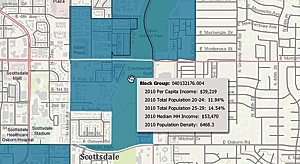The Power of Place in Retail

Using Business Analyst Online helps retailers get the full picture of all the data that is crucial to making a more informed business decision, including geographic location, income, and population counts.
Technology and the recession have changed retailing forever. Gone is "Clonetown USA"; its repetitive retail landscape has been redesigned to engage customers on their own terms. Today, it's all about doing business locally—bringing stores to the customer rather than expecting the customer to seek out products at particular stores. More and more potential customers are using smartphones to do this.
Recent statistics have shown that more than half of shoppers consult their smartphones and other mobile devices while shopping in order to compare prices or find the best place to purchase products. If these mobile shoppers search for a store, they usually visit it, and a little more than half make a purchase. While this may seem positive, these numbers reflect a marketplace where consumers have many ways to search for a particular item. Once found, that item can be easily located at the nearest store at a price the customer is willing to pay. To make matters even more competitive, smartphone applications can provide incentives that drive customers out of one store to a competitor's site. Suddenly, all the work a store owner has done to optimize the price, quantity, and assortment mix of merchandise may be lost.
Esri Business Analyst provides location intelligence to retailers and other business owners who want to harness the power of location intelligence and put themselves back in the driver's seat when it comes to attracting customers. By merging demographic and business data, detailed maps, advanced spatial analytics, and their own data, they can make more accurate decisions about business operations, including how best to engage customers and create a more profitable marketplace.
Place Matters in Retail
Retailers are realizing that they need to keep on top of these trends, and that means place matters. Where they open their storefronts and whether they can reflect the locality in their businesses are the new normal. Many companies now differentiate merchandise assortments so they are tailored to local tastes and market potential. In today's competitive marketplace, every retailer understands that its bricks-and-mortar strategy has got to be about fulfilling customers' needs in every store, in every market, everywhere.
This shift to local, store-specific awareness means an explosion in the size and types of data that need to be tracked, stored, analyzed, cross-tabulated, and made sense of. Data from customer relationship management systems, loyalty programs (such as grocery store club cards), online and web marketing, local promotions, coupons, and store-level transactions all need to be collated.
That's where location analysis and Business Analyst come in. Business Analyst enables users to identify, track, and understand every customer shopping at that particular store and get actionable intelligence about why, shifting the power back to the retailer. With Business Analyst Online, retailers can access this location analysis from a smartphone. Using this technology, key demographics and market facts about any location in the United States can be accessed on an enterprise scale, from the corporate office to each retail location. The very systems that marketing managers are using to optimize the competitive landscape in corporate headquarters are now also the very ones that can enable savvy shop owners to shift their focus and understand their local customers better.
For more information, visit esri.com/ba.
See also "Mobile Access to Market Data."
Related Podcast
Understanding the American Consumer
Matt Carmichael, director of information for Ad Age magazine, discusses using GIS technology and data to understand demographics and consumer trends. Listen to the podcast. [11:00 | 11 MB]